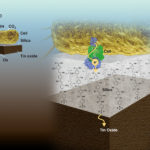Biosciences researchers have developed a novel nanoscale membrane embedded with molecular wires that simultaneously chemically isolates, yet electrochemically couples, a microbial and an inorganic catalyst on the shortest possible length scale. This new modular architecture, described in a paper recently published in Nature Communications, opens up a large design space for building scalable biohybrid electrochemical systems for a variety of applications.
A Core−Shell Nanotube Array for Artificial Photosynthesis
“The key design principle of natural photosynthesis is the closing of the photosynthetic cycle on the shortest possible length scale under membrane separation of the incompatible water oxidation and proton reduction environments,” said Heinz Frei, a senior scientist in Biosciences’ Molecular Biophysics and Integrated Bioimaging (MBIB) Division. With collaborators Eran Edri, a former postdoctoral fellow in MBIB now at Ben-Gurion University, and Shaul Aloni in the Molecular Foundry Division, Frei developed a fabrication method to make a square-inch sized artificial photosystem, in the form of an inorganic core-shell nanotube array, that implements this design principle for the first time. The method was described in a paper published earlier this year in ACS Nano.
X-ray Footprinting Reveals Secrets of ‘Metal-Breathing’ Bacterium
A team of Berkeley Lab researchers conducted X-ray footprinting mass spectrometry (XFMS) experiments at the Lab’s Advanced Light Source (ALS) to pinpoint how a protein of the bacterium Shewanella oneidensis transfers electrons to a metal oxide substrate. The research was led by Caroline Ajo-Franklin, whose lab is part of the Molecular Foundry and who holds a secondary appointment in the Molecular Biophysics and Integrated Bioimaging (MBIB) division, in collaboration with Corie Ralston, also of MBIB. Tatsuya Fukushima, a former postdoc in Ajo-Franklin’s lab, and Sayan Gupta, a member of Ralston’s lab, were co-first authors on the paper published in the Journal of the American Chemical Society. The study, which identified an unexpectedly small and weak binding site, also benefitted from expertise and tools contributed by Joint BioEnergy Institute (JBEI) and Biological Systems and Engineering (BSE) researchers Christopher Petzold and Leanne Jade Chan. Read more at the Berkeley Lab News Center.
Was this page useful?





